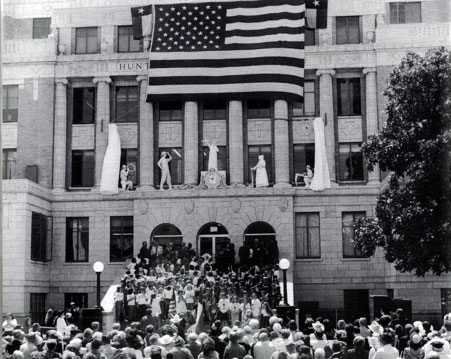
In 1991, Hunt County celebrated its 145th birthday. As a member of the Hunt County Historical commission, I was one who contributed maps of certain parts of the county they believed to have been significant in 1846 and still be important. My route began at the courthouse since I had researched materials for the two Texas Historical Commission (THC) markers on the courthouse square.
Let’s take that tour from 1991 to consider what has remained, what has been repurposed, and what disappeared. I will write the 2021 tour in three weeks, adjusting it as needed. However, I want and need your help. What do you remember of that area of Greenville? Please feel free to tell me what you remember. I have only lived in Greenville since 1974. I will leave my contact information at the end of this article.
So, let’s begin at the courthouse. Constructed in 1929 it barely made it before the Great Depression. It is truly an interesting building that is often rearranged within those stone walls. For more information, stop by the two historical markers on the northwest corner of the square.
We will start on Johnson Street, named for an early Texas Ranger who was also an Indian fighter. He acquired an enormous amount of land located north of Crockett Elementary School. At the northeast corner of Lee and Johnson Streets is an interesting building. Constructed in 1915, it is the home of the IOOF, International Order of Odd Fellows. The fraternal organization was first created shortly after Greenville was formed. They hold meetings on the second floor, but the ground floor has been an automobile dealership, a florist, an extremely interesting hardware store, the first home of Citizens State Bank, and where the Hunt County Museum (now the Audie Murphy/American Cotton Museum) first opened its doors.
Just north of the Odd Fellows is a white brick sprawling site. Originally it was a Coca-Cola plant, one of the last with private owners. When the Alexanders sold out to the national business, the family donated the building to the City of Greenville where it is used by part of the city set-up. Next door is a delightful two-story home that looks like it is part of a Southern plantation. The Alexanders sold the home in the late 1990s.
At 2203 Johnson Street is a house that was supposedly occupied by Union soldiers after the Civil War. Yes, all of Hunt County was dangerous with returned Rebels who wanted to anihilate all Unionists and former slaves. Northeast Texas was a hotbed of violence into 1870.
When you come to Bourland Street, turn right and visit the first Greenville park. It is on the edge of Cow Leach Creek, the headwaters of the Sabine River. When I was there, I found an old playground used by children for more than one hundred years.
Back on Johnson Street the road divides. As you turn onto Sockwell Boulevard look for two places are part of the town’s past. The land becomes the flood plain of the Sabine, but in all the mud and trees there was once a baseball field for boys after World War II. A short distance on the right is a yellow house that was once a sanitorium for drug and alcohol addicts. That deserves an article of its own, though.
Across the street is Graham Park, once a thriving place on afternoon for picnics, ballgames, playgrounds, and lovely gardens. For several years the Ende-Gaillard Home was located there until it was moved to the museum. Leaving the park and turning onto Walnut Street see if you see a brick roundhouse used by the Electric Street Railway.
On Walnut Street, look at the lovely homes built in an 1890 housing development that expanded the entire western part of town. Many of the homes are still standing. You can see them if you turn left from any side street. When you reach Lee Street, you will be close to the old Houston School. Here is an example of repurposing a building. The school served as an elementary school for many years, until it was converted into the Houston Education Center housing New Horizons High School, Greenville GAEP, and Newcomers Center.
At Lee Street turn left to drive through an area of more old homes. At the railroad tracks, you must turn right and then left onto Washington Street. At Wesley Street you will see interesting places on each corner. The WOW sight is Central Christian Church, a stellar church in red brick. To the right is the post office in the building that was once a bank, and to the west is Greenville Municipal Building. Across the street is a tan brick building that was home to professional businesses but victim of a freak storm in 2019. Looking at the site across from the church, one can see the remnants of one of the first gasoline stations.
Follow Washington Street two blocks back to the courthouse. Along the way you may have seen other intriguing places. Feel free to include them in your inventory of old and changed places in northwest Greenville. Thanks so much. Carolcoleytaylor@gmail.com
